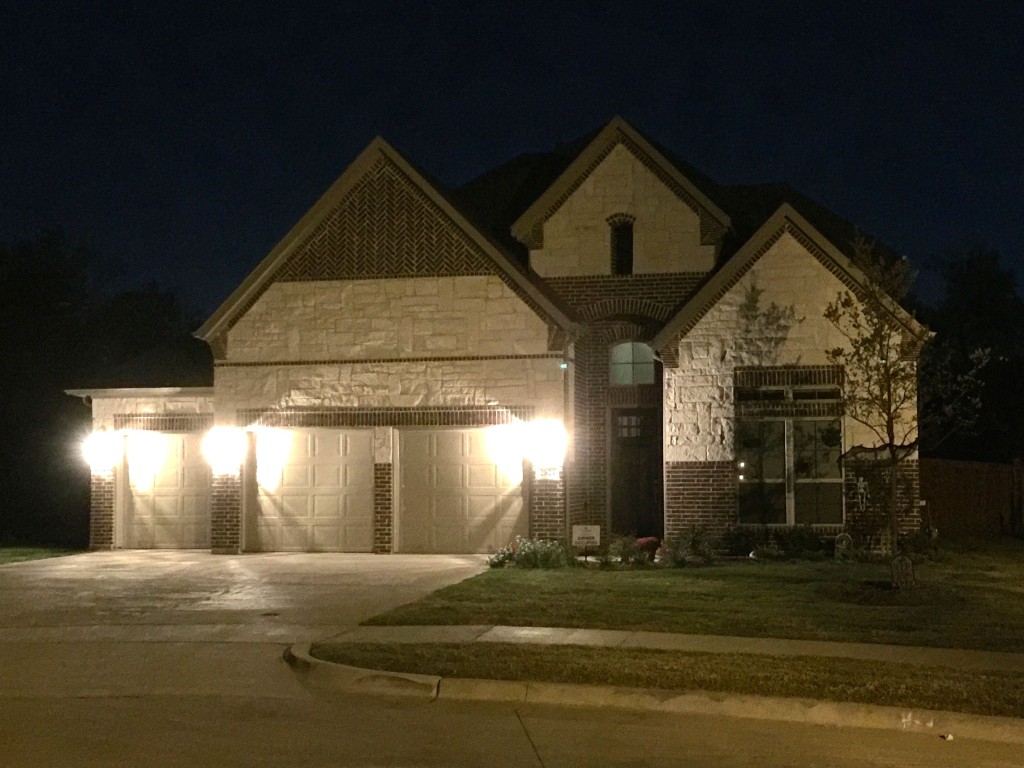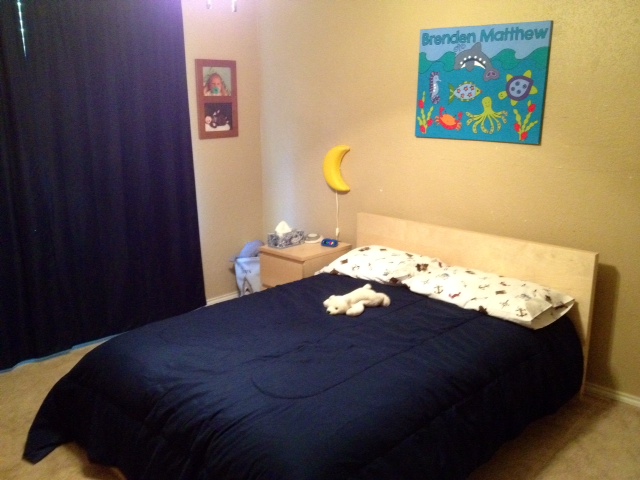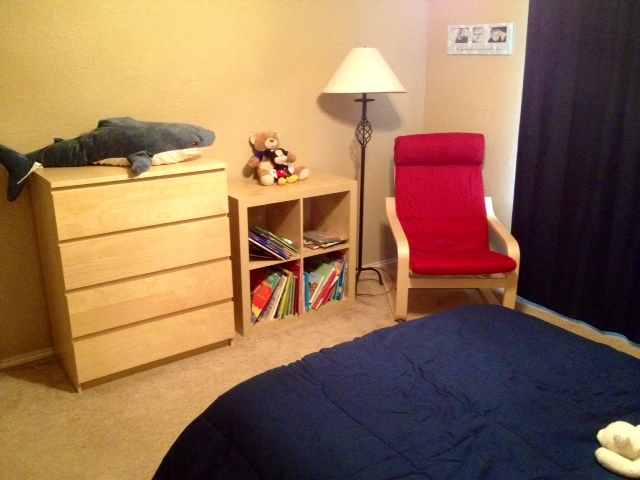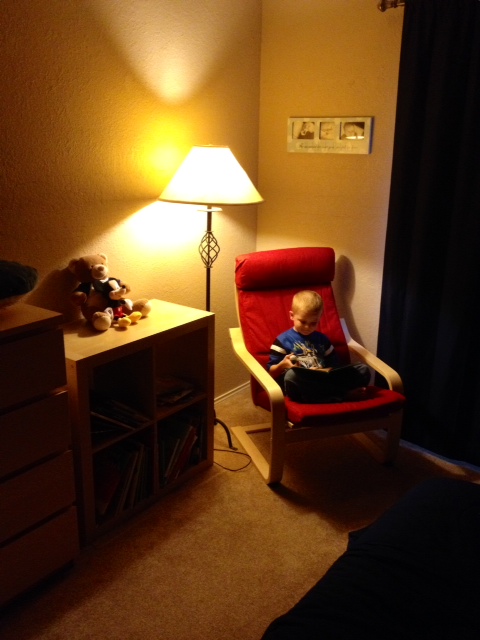
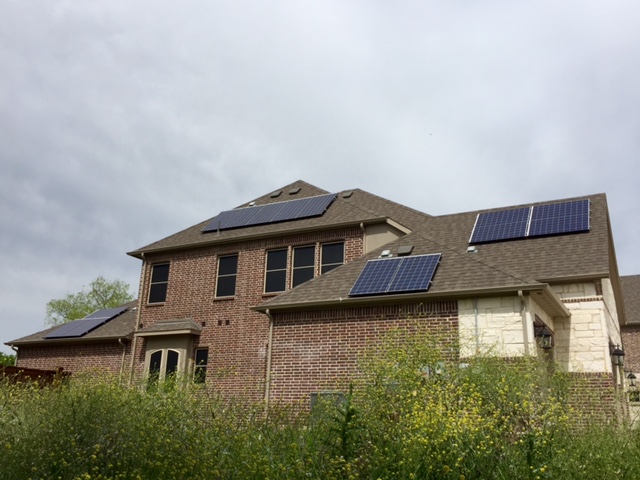
After years of waiting for the right house and the right time, I finally installed a solar panel system in March 2016. Technically known as a solar photovoltaic or solar PV system, it sits on my roof and converts sunlight into electricity both for our own use and for the electric grid that we all share. For those who might be interested, here are more details than you probably wanted about the planning and installation process, costs, and benefits.
Basic Details
Don’t want to read the novel that follows? Here are the basics:
| Size: |
7 kW, 28 panels in 7 arrays facing east and west |
| Net Cost: |
$12,856 after all incentives, or $1.84/watt |
| Estimated Production: |
700-780 kWh/month and 8300-9300 kWh/year |
| Estimated Savings: |
$75-80/month and $900-1000/year |
| Estimated Payback Time: |
10.7-12 years |
Initial Thoughts
Our house is rectangular in shape and faces roughly south, with the narrower sides on the north and south. In the Northern Hemisphere, due south is the ideal orientation for solar panels, but we didn’t have much south-facing roof. The HOA said we could install panels on the west and east sides but not the south side facing the street. I don’t know if that prohibition is technically legal or not in Texas, but since our south roof didn’t have much room anyway and I didn’t feel like a huge battle, I went with it. So my goal was to put as many panels as possible facing east and west to maximize our production, assuming the cost wasn’t too high. Off I went.
Shopping Around
For a project this big, I wanted at least three bids. After researching DFW companies and their reviews online, I contacted four solar companies in November 2015:
- Longhorn Solar – They seemed like a great company. They said they would get in touch once some Oncor rebate information got published later that month. They never bothered to respond. Either they’re swamped with projects or don’t like money.
- Native Solar – They are Austin based but also install up here. I talked to a super nice guy for quite a while over the phone, and he was trying to design a system for my roof using satellite imagery. Yes, that’s somewhat possible using their modeling software. After a few weeks of waiting on rebate info and the guy trying unsuccessfully to fit as many panels on my roof as the competition could, I finally figured out the problem: he was looking at the wrong house. I didn’t think it was worthwhile to continue down the Native path.
- SolarCity – My friend Donny in Euless leased solar panels a few years ago from SolarCity and was very pleased. He actually got the ball rolling for me by hosting a “learn about solar” event at his house in October. I met his sales guy there and later got a bid from him. SolarCity focuses almost exclusively on leases and power purchase agreements. Both are flavors of the same idea – SolarCity installs, owns, and maintains the system on your roof, and you pay them either a monthly leasing fee or pay them for the power that the panels produce. Both are an interesting way to reduce or eliminate the high up-front costs of buying your own system, but there are some drawbacks. I wanted to purchase my system. SolarCity also sells systems, but the sales guy said he hadn’t actually sold any yet.
Of the two initial bids I actually got for purchasing a system, SolarCity’s was lower. However, the super-nice and enthusiastic sales guy was proposing that we install panels all over the north side of the house as well, facing away from the sun. He said that’s normally what they recommend, just put up as many as you have room for. Even as a solar rookie, I knew the north-facing panels would produce significantly less electricity and were not very cost-effective. So the fact that he would recommend them told me his goal is simply to sell as many panels as possible regardless of their benefit to me. I also did some research on SolarCity afterward and found a ton of reviews from unhappy customers, especially in California. So despite my friend’s good experience with SolarCity, I was leery.
- PetersenDean – Fortunately, I got another bid, the one I selected. PetersenDean is a roofing and solar company, which was an unusual but smart combination. They operate in California and Texas and have excellent reviews. Clint, the sales guy, seemed genuinely interested in helping me select the right system for my house rather than selling me the biggest system possible. He actually recommended a west-only configuration due to the way our house faces. The western side faces a 240 degree azimuth, or west-southwest. That’s good for solar production. The eastern side faces 60 degrees, or east-northeast. That direction can produce power, but anything facing north of 270 or 90 degrees is not ideal. Clint recognized that and didn’t even suggest any eastern panels, much less northern ones like the SolarCity guy. They also sell only American-made panels rather than Asian or European ones.
PetersenDean’s initial bid was a bit higher per watt than SolarCity’s, but the system sizes were significantly different, which likely played a role. Cost per watt is the simplest way to compare bids between companies due to differences in system size and other factors. Once I had gotten two bids, I told Clint that I liked the company but his bid was higher. He offered me a discount on some slightly less efficient panels (250 watt vs 275 watt) they had sitting in the warehouse that they wanted to clear out, “last year’s model,” if you will. I also told him I wanted to add panels on the east side as well so I could produce for as many hours in the day as possible. He worked up a new bid that looks great.
So I didn’t actually get bids from three different companies, only two. But I doubted anyone would beat PetersenDean’s bid and felt good about them, so I signed with them.
Our Usage
Although I wanted to produce as much electricity as I could, I also wanted to know how much electricity we used and how much we could offset with the panels. Our house is brand new and energy efficient, including gas heat instead of electric like we had in our previous house in Euless. Despite living in Texas where summer days often top 100 degrees, our winter electric bills in Euless were significantly higher than the summer bills due to the inefficiency of electric heat. So in our new house in Grand Prairie, we need to look at two aspects of our usage: daily activities (lighting, appliances, etc.) and running the air conditioner during the warm months.
Oncor, our electric delivery company, uses the fancy new smart meters to gather detailed data about our usage and makes it available online at SmartMeterTexas.org. If you live in north Texas, Oncor is probably your delivery company, and you can sign up to see your own usage data. It shows you not just how much you use per day and month, but down to fifteen-minute increments. Using this data and a bit of research, I tweaked our house a bit to reduce our daily usage, mostly by replacing many of our incandescent bulbs with LEDs and CFLs.

Once I made our house more efficient, we were averaging about 17 kWh per day or about 520 kWh/month. If I were paying 10c/kWh, that’s $1.70/day just to keep the lights on and run the washer/dryer, computer, media room, etc. So I wanted to produce at least that much electricity per day.
The other piece is the air conditioner. Since we haven’t lived here a full summer, I don’t have good data for our summer usage. We moved in August 9 and didn’t get around to programming our goofy Honeywell Lyric thermostats until maybe September. But our September and October data indicated that our air conditioners (one upstairs unit and one downstairs unit) were using more energy than running all the other stuff in the house combined. We added solar screens from Lone Star Solar Screens in March to block out some of the heat and reduce our A/C load. Unfortunately, due to the timing on the solar panels and screens, I won’t be able to compare our summer usage before and after we went solar. But I’m sure it will help.
All in all, I estimated our annual usage without the solar panels at about 11,400 kWh, or 951 kWh/month. But keep in mind that’s roughly 520 kWh/month from November through April and then a big spike during the summer.
Planning and Installation
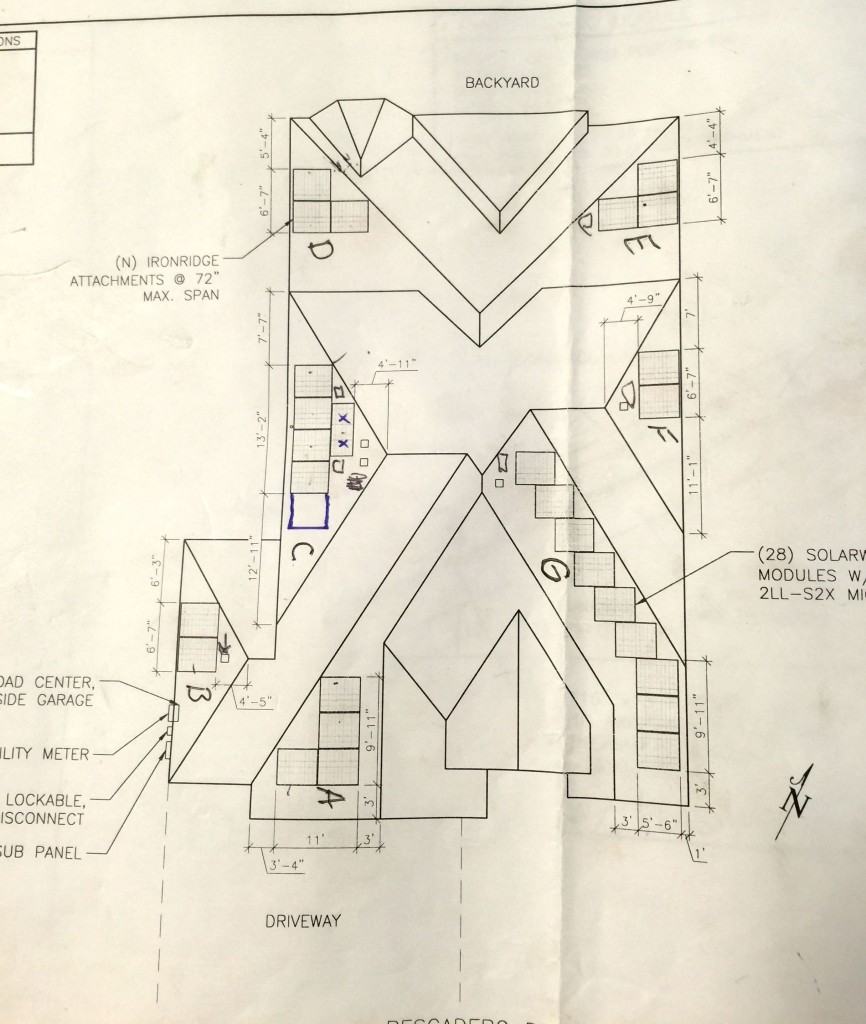
Installing a solar PV system is a months-long process. I signed the initial contract in November 2015, and they finished the installation in March 2016. After I signed the contract, PetersenDean’s tech folks designed the nuts and bolts of the system. It needed to comply with the electrical code, fire code (turns out you have to leave some space on the roof for firefighters to walk around if necessary), and local building code on top of being a viable system. We selected SolarWorld’s SW 250 Poly panels, rated at 250 watts.
Unfortunately, although we initially agreed on an 8 kW system (32 panels of 250w each), the solar engineer determined that we only had room for a 7 kW system, or 28 panels. That saved me some money up front but also cost me some production. The panels are roughly 3 feet by 5 feet and aren’t generally available in other sizes, which limits the installation options. Also, I initially wanted 24 panels on the west side and 8 on the east, since the western panels would produce more and were eligible for the Oncor rebate (more on that later), due to space constraints, we had to split them up evenly. So the final design has 14 panels west and 14 east. It’s not optimal for production, but like with any project, you make the compromises you need to make. Due to all the different faces on our roof, they had to split our system into seven different arrays (see above).
To estimate my solar production, I used a nifty calculator provided by the U.S. Department of Energy called PV Watts. It allows you to enter your location and PV system details (size, direction, tilt, etc.) and calculate roughly how much electricity your panels will generate by month. I used this data to build a spreadsheet that compares my production to my usage and estimate what percentage I could offset. The warmer months are highlighted in orange since they’ll add usage for the air conditioner.
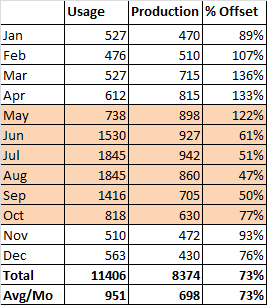
The installation process itself took a few days, partly because our roof is really steep and partly because the system has so many different arrays to install and link up. The panels attach to metal rails that are screwed into the roof. The electrical wiring runs through the attic to a subpanel on the outside of our garage. So although the arrays are spread all over the roof, it looks clean because most of the wiring is hidden in the attic. Our system uses microinverters, which are more expensive but also more efficient and better suited for a system like ours that is spread out and has different arrays producing during different times of the day. The PetersenDean installation crew was very nice, worked hard, and did a great job under challenging conditions.
Costs
The cost of going solar has dropped steadily over the last several years, largely because the panel manufacturers are finding ways to make them cheaper. The tax code still provides a 30 percent tax credit for the entire out-of-pocket cost of the system. Also, some states and local utilities provide additional financial incentives. So solar might be cheaper than you think. Also, if you prefer not to pay for the entire system upfront, solar loans are becoming available from some banks. Some require no money up front.
For our 7 kW, 28-panel system, the initial cost was $20,640. But Oncor, our electricity delivery company that maintains the power lines and transformers, was offering a rebate through their Take a Load Off Texas program. Our west panels qualified for a rebate of $0.65/watt of capacity, or $2275. The east panels faced north of 90 degrees and did not qualify.
Why would Oncor want us to install solar panels? A solar PV home is a tiny power plant that creates electricity during the day. In Texas, the biggest electrical load we have occurs during summer afternoons, and Oncor needs enough power in the grid to keep millions of homes and businesses cool. The more homes generate their own power, the less need they’ll have to fire up their standby power plants or build new ones to handle the maximum possible load.
I like thinking of our home as a tiny power plant.
So our actual out-of-pocket cost was $18,365. But remember we can claim a 30 percent tax credit – not a deduction, but a dollar-for-dollar reduction of our tax bill. So after subtracting $5510 for that, our net cost for the system was $12,856.
Selling Our Extra Electricity
During the day, especially when the air conditioner isn’t running but it’s sunny outside, the panels produce more electricity than we use. It’s possible to add huge batteries like Tesla’s Powerwall to store that electricity, but they are expensive and don’t seem very cost-effective to me. The other option is to sell the excess power back to the power company. Sounds good, right? Right now only a few Texas power companies buy power from consumers. Green Mountain Energy is the best deal right now. They buy back excess power at the same rate you buy it from them. So on a typical sunny day, we overproduce from about 8:00am until about 6:00pm. During that time, we’re pumping power back into the grid, and our smart meter tracks it for us. At night, when it’s cloudy, or when we’re otherwise using more than we’re generating, we buy electricity from Green Mountain. So most months we’ll have a small electric bill, but other months (probably Feb-Apr) we’ll have a credit.
Benefits So Far
Based on my initial estimates, the system would produce 8374 kWh per year, offsetting about 74 percent of our electrical usage and saving $888 annually. Assuming the cost of electricity will go up about 3 percent annually due to inflation, our payback time would be around 12 years with a 6.9 percent return on investment in the first year (ROI).
However, after running the system for about a month, our actual power generation is higher than predicted.
We added monitoring capability so I can geek out on our production numbers, which I can view through a website or an app. I check the app throughout the day. They set up a public view of my system so you can check the production from day to day and see how it varies with the weather.
Here’s a screenshot of the website:
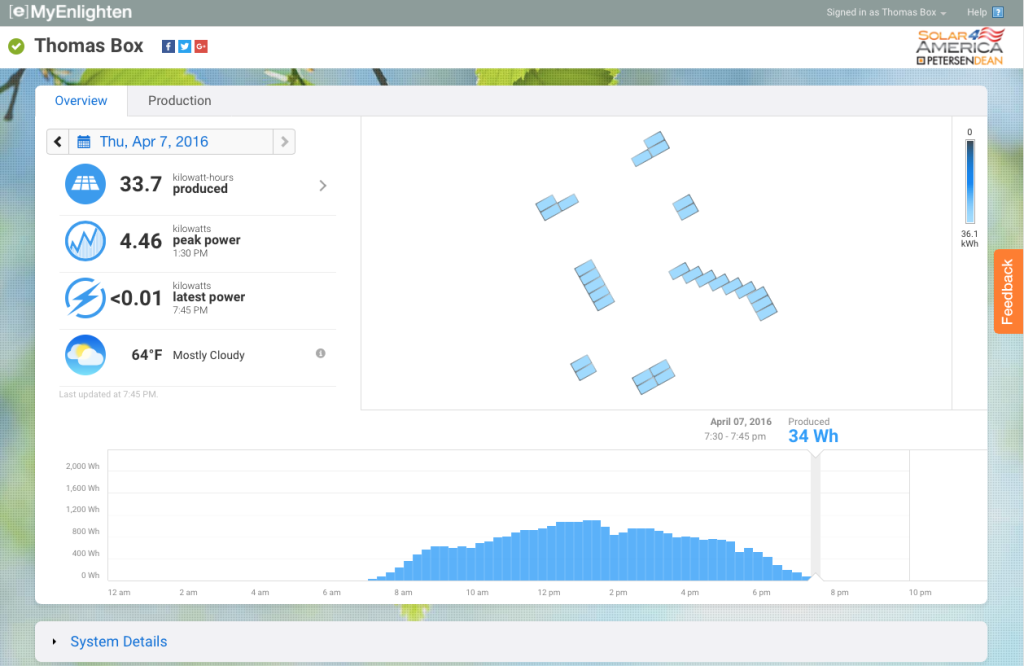
On a sunny day, we currently produce 30-35 kWh per day, nearly double the 17 kWh that we use. An overcast day drops that number roughly in half, and rainy days do less than that. On average since March 23, when we activated our system monitoring, we’re averaging 30 kWh/day. At that rate, we’re looking at roughly 900 kWh for this month versus the 765 kWh that the PV Watts calculator predicted for mid-March to mid-April. So we’re exceeding our estimate by nearly 18 percent. I can wait to see how they do this summer.
On average, at the 10.8c/kWh rate we’re paying, our monthly electric bill should be $20-30 with the panels versus $105 without them. So we’re saving roughly $75-80/month.
Here’s our daily usage on a sunny day after installation. From about 8:00am until about 6:00pm, we were selling power back to Green Mountain, effectively running the meter backward.

Conclusion
We are thrilled with our system and very happy we chose PetersenDean. Actually, we hope to add to our system at some point if we can figure out the right way to do it. We wound up with a bit of extra space on part of our western roof that could hold one or two more panels. More importantly, we might add a solar pergola in the backyard to increase our capacity by a few kilowatts. If you have any questions or want to speak with my contact at PetersenDean about getting a free estimate, contact me.








